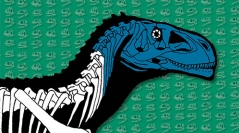

 Comptes Rendus Palevol
19 (6) - Pages 101-115
Comptes Rendus Palevol
19 (6) - Pages 101-115Abelisaurid theropods dominated the predator role across Gondwana during the Late Cretaceous. They are characterized by highly reduced forelimbs and one of the most specialized cranial morphologies among carnivorous dinosaurs, exemplified by a broad skull, short rostrum, high occipital region, and highly kinetic intramandibular joint, suggestive of a specialized feeding strategy. Late Cretaceous abelisaurids are known from some remarkably complete taxa with well-preserved skulls. However, little is known about the pattern of character transformation that led to their highly modified condition because there are no well-preserved abelisaurids before the Late Cretaceous. Here we report a basal abelisaurid from the Early Cretaceous of Brazil that preserves a complete skull and reveals an early stage in the cranial evolution of the group. It lacks the specialized temporal and mandibular features characteristic of derived abelisaurids, including the kinetic intramandibular joint and knob-like dorsal projection of the parietals.
Abelisauridae, Quiricó Formation, Ceratosauria, Aptian, new genus, new species